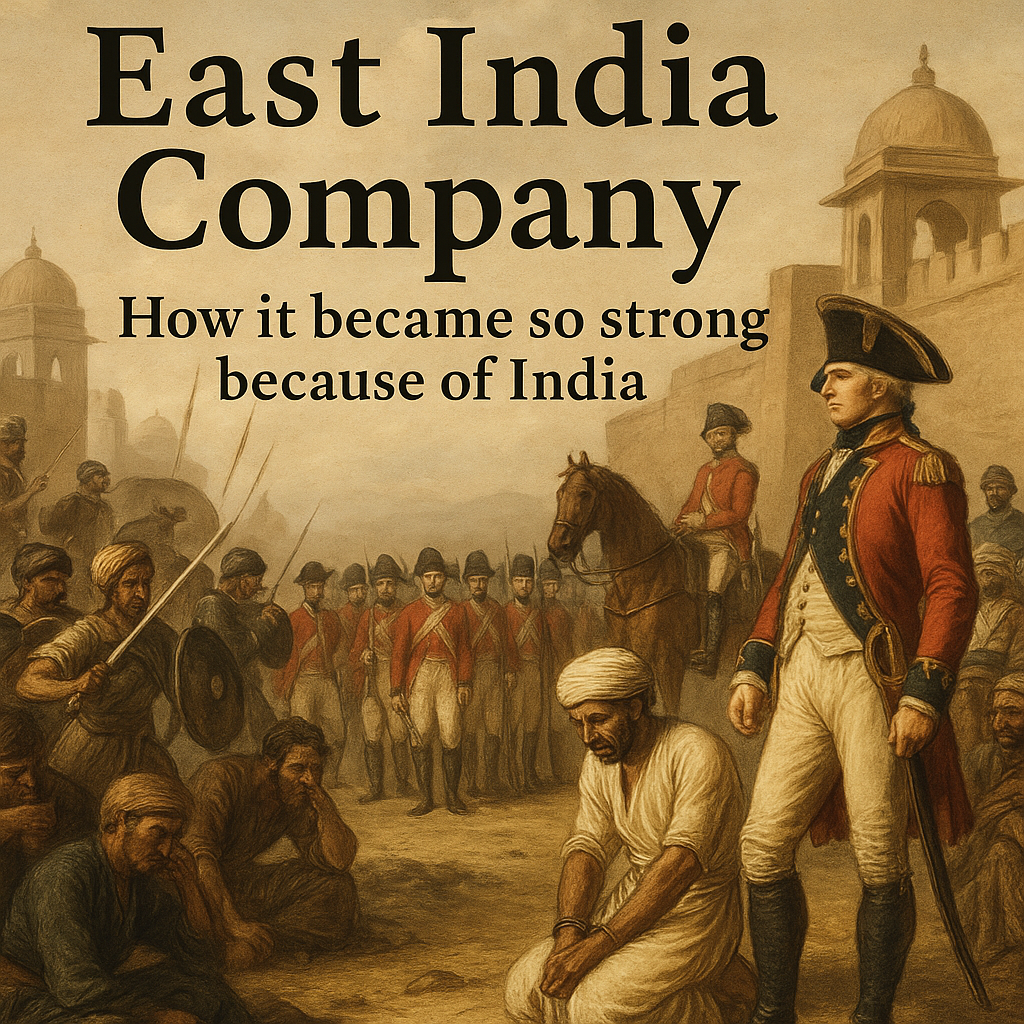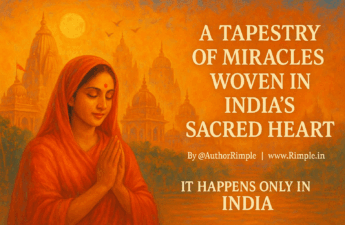The East India Company (EIC) started as a small group of British traders but turned into a monster that ruled over nations. It became stronger than many countries by exploiting India, looting its wealth, and using cruel tactics to control the Indian people. India, with its riches and resources, was the main reason for the EIC’s rise to power. However, their success came at a terrible cost—India was plundered, its people were tortured, and its brave Hindu rulers were crushed. The EIC were smart strategists, but they were also villains who brought suffering to millions.
How the East India Company Started
The East India Company was born in 1600 when a group of greedy British merchants got permission from their queen, Elizabeth I, to trade in the East. They wanted to make money by bringing spices, silk, and other goods from Asia to Europe. The queen gave them a special charter, which was like a license to trade and even use weapons to protect their business. This charter also allowed them to act like a small government—they could make their own rules, build armies, and fight wars.
- Their First Steps: The EIC sent ships to places like Indonesia and the Spice Islands to set up trading posts. They used a ship called the Red Dragon to start their trade.
- Early Fights: They fought with other European traders, like the Dutch and Portuguese, to control trade routes. In 1612, they won a big battle against the Portuguese at Swally, which gave them confidence to expand.
The EIC soon turned their eyes to India, a land of immense wealth, with bustling cities, fertile lands, and skilled artisans. India was the key to their dreams of becoming a global power.
Why India Was So Important to the EIC
India was like a golden treasure chest for the EIC. India was referred to as the “Golden Bird” (Sone ki Chidiya) due to its immense wealth and prosperity, particularly during ancient times. This was a result of its thriving trade, advanced agricultural practices, rich cultural heritage, and abundant resources like gold, gems, spices, and other valuable commodities. It had everything they wanted—spices, cotton, silk, jewels, and more. Indian cities like Surat, Bengal, and Madras were rich trading hubs, and the EIC saw a chance to make huge profits. India’s wealth was the main reason the EIC became stronger than most countries.
- Rich Resources: India produced the best cotton and silk in the world. The EIC sold these goods in Europe for a lot of money.
- Huge Markets: Indian markets were full of people buying and selling goods. The EIC wanted to control these markets to make more profit.
- Weakened Local Rulers: After years of invasions by foreign forces, some Indian rulers were weak, and the EIC took advantage of this to gain power.
India’s riches made the EIC greedy. They didn’t just want to trade—they wanted to control India completely and take all its wealth for themselves.
How the EIC Became Stronger Than Most Countries
The EIC used clever strategies to take control of India, but their methods were cruel and unfair. They didn’t care about the Indian people—they only cared about power and money.
Building a Private Army
The EIC created its own army, which was bigger than the British army itself. They hired Indian soldiers, called sepoys, but trained them with European weapons and tactics. This gave them an edge over Indian armies.
- Winning Battles: At the Battle of Plassey in 1757, the EIC defeated a huge Indian army of 50,000 with just 3,000 soldiers. In 1764, at the Battle of Buxar, 7,000 EIC troops defeated 40,000 enemies.
- Control Through Force: Their army grew so big that they could force Indian rulers to obey them or face war.
Divide and Rule: Turning Indians Against Each Other
The EIC knew they couldn’t fight all of India at once, so they used a dirty trick called “divide and rule.” They made Indian rulers fight each other, so they could step in and take control.
- Creating Enemies: The EIC would support one Indian king against another, promising help in wars. Once the fighting was over, they would betray the winner and take over their land.
- Bribing Leaders: They paid some Indian leaders to work for them, creating distrust among the people.
This strategy weakened India and made it easier for the EIC to rule.
Taking Over Trade and Land
The EIC started by setting up small trading posts, but these soon turned into huge factories that controlled entire regions. They forced Indian farmers and workers to produce goods only for them.
- Forcing Farmers: Farmers were made to grow crops like indigo and opium instead of food, leaving many hungry.
- Stealing Land: The EIC took over fertile lands in Bengal, Bombay, and Madras, calling them “Presidencies.” They ruled these areas like their own kingdoms.
How India Made the EIC So Powerful
India was the main reason the EIC became stronger than most countries. Here’s why:
India’s Endless Wealth:
India had everything the EIC wanted—cotton, silk, spices, indigo (a dye), and later tea and opium. These goods were sold in Europe for huge profits, making the EIC very rich.
Lots of Workers:
The EIC built big factories in India where hundreds of Indians worked to make goods. These factories were in places like Madras, Bombay, and Calcutta. The cheap labor in India helped the EIC make more money.
A Place to Grow Their Army:
India gave the EIC a place to build and train its army. Many Indian soldiers (called sepoys) joined the EIC’s army, which made it even bigger and stronger.
Money to Fund Everything:
The taxes and profits from India gave the EIC the money to pay for ships, soldiers, and more trading posts around the world. Without India’s wealth, the EIC couldn’t have grown so big.
How the EIC Looted India
The EIC didn’t just trade in India—they robbed it. Here’s how they took India’s wealth:
Heavy Taxes:
They forced Indians to pay high taxes, even when they had no money. If people couldn’t pay, their lands and properties were taken away.
The Bengal Famine (1770):
In 1770, a terrible famine happened in Bengal, killing about 10 million people (one-third of Bengal’s people). The EIC didn’t care—they kept taking taxes and even sent food to Europe while Indians starved.
Stealing Treasures:
EIC officials, called “nabobs,” took India’s treasures for themselves. The EIC took gold, silver, diamonds, and jewels and other valuables from Indian kings and temples. They sent these treasures to Britain to make themselves rich. For example, the Koh-i-Noor diamond, now in the British Crown Jewels, was taken from India during this time.
Destroying Local Business:
The EIC forced Indians to make goods only for them, like cotton and silk, and stopped them from selling to others. They also brought British goods to India, which destroyed Indian businesses like weaving and farming.
The Cruelty of the EIC: Torturing Indians
The EIC treated Indians very badly. They cared only about money, not people. Here’s how they were cruel:
The EIC didn’t just steal from India—they treated Indians with extreme cruelty. They saw Indians as less than human and used violence to control them.
- Killing Innocent People: The EIC killed thousands of Indians who resisted them. They burned villages and massacred entire communities.
- Torturing Rebels: Indians who fought back were tortured in horrible ways—some were tied to cannons and blown apart as a warning to others.
- Forcing Labor: The EIC made Indians work in terrible conditions, like slaves, to build their factories and roads.
- Destroying Culture: They disrespected Indian traditions and forced their own laws on the people, trying to erase India’s ancient culture.
The EIC’s cruelty showed their true nature—they were heartless villains who cared only about power.
Brave Hindu Rulers Who Fought the EIC
Despite the EIC’s power, many brave Hindu rulers and warriors fought against them. They showed incredible courage and love for their motherland, India.
Rani Lakshmibai: The Fearless Queen of Jhansi
Rani Lakshmibai, also known as the Rani of Jhansi, was a brave Hindu queen who fought the EIC with all her might. She became a symbol of resistance against British rule.
- Her Fight for Jhansi: The EIC tried to take her kingdom, Jhansi, after her husband died, saying she had no right to rule. But Rani Lakshmibai refused to give up her land.
- Leading an Army: She led an army of men and women to fight the EIC in 1857. She rode into battle on horseback, sword in hand, inspiring her soldiers.
- Her Bravery: Even when the EIC attacked Jhansi, she fought until her last breath, dying as a hero in 1858. Her courage still inspires Indians today.
The Mighty Marathas
The Maratha Empire was a powerful Hindu kingdom that fought the EIC and other invaders with great strength.
- Defending India: The Marathas, led by warriors like Tukoji Rao Holkar, fought to protect India from foreign invaders. They defeated many enemies, including cruel invaders who attacked Hindu temples and people.
- Battles Against the EIC: The Marathas clashed with the EIC in many wars, like the Anglo-Maratha Wars. They fought bravely but were eventually defeated because of the EIC’s tricks and larger army.
The Courageous Rajputs
The Rajputs of Rajasthan were known for their bravery and honor. They never bowed to foreign invaders, including the EIC.
- Protecting Their Land: Rajput kings like Maharana Pratap had a history of fighting invaders, and they continued this tradition against the EIC.
- Sacrificing Everything: Rajput warriors would rather die than surrender. Their women also fought alongside them, showing unmatched courage.
Other Hindu Heroes
Many other Hindu rulers and communities resisted the EIC, including the Sikhs in Punjab and local leaders in Bengal and South India. Women, too, joined the fight, proving that Indians would never give up their freedom without a battle.
The EIC’s Downfall: India Fights Back
The EIC’s cruelty and greed led to their downfall. In 1857, a huge rebellion broke out in India, called the Sepoy Mutiny or the First War of Independence. Indian soldiers in the EIC’s army, along with common people, rose up against them.
- The Rebellion: Indians from all over the country fought the EIC, inspired by leaders like Rani Lakshmibai. They wanted to drive the British out of India.
- The EIC Weakens: The rebellion was so strong that the EIC couldn’t control it. The British government had to step in and take over India directly, ending the EIC’s rule.
In 1858, the British Crown took control of India, and the EIC was shut down. But the damage they had done to India would take years to heal.
The EIC: Smart Villains Who Destroyed India
The East India Company was a group of smart strategists—they knew how to use their army, divide people, and control trade to become more powerful than most countries. But they were also villains who brought misery to India. They looted India’s wealth, tortured its people, and crushed its brave Hindu rulers. India, the land of ancient wisdom and riches, suffered greatly because of their greed.
The EIC’s story is a lesson for the world: no matter how clever or powerful you are, cruelty and injustice will always lead to your downfall. India, with its brave heroes like Rani Lakshmibai, the Marathas, and the Rajputs, showed the world that no force can break the spirit of a nation that fights for its freedom. The EIC may have won battles, but India’s heart and pride could never be conquered.





